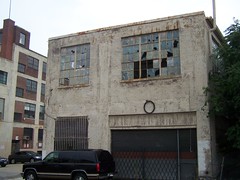Trading buildings to cover property tax obligations
Doug Jemal is a major developer in DC. He's an unusual guy. He's fine with owning and rehabilitating historic buildings, not merely interested in tearing them down.
On the other hand, he gets an idea in his head about how he wants to develop a building and what price he wants to receive in rent, and he will wait and wait and wait and wait until he gets his price and his idea, which can mean that buildings stay empty for a long long long time, a decade or more. (On the other hand, he is a patient investor, and committed to the city, and to urban markets more generally.)
Recently, the Washington Business Journal reported, in "Douglas Jemal owes D.C. nearly $6 million — 10 percent of all outstanding property taxes due the city" that he owes the city a lot of money, but he doesn't have the cash to pay the bills.
Last night I went to that meeting in the Shaw neighborhood about what to call the arts district there and whether or not to expand it (more about that later).
As I was riding up 7th Street on my way home, it occurred to me after looking at one of Jemal's buildings (the old bakery that sits next to the Shaw/7th Street subway stop at S Street), that it would be better for the city and for Jemal if he would just give the city a building ts payment in full of this debt.
It would be far far far far better for DC if buildings that Jemal owns in at least three parts of the city were under different ownership, or even the city's ownership, so that they could be utilized today, instead of continuing to remain negative assets--empty disinvested hulks.
1. The Uline Arena (pictured above) is an old concert and sports hall next to the New York Avenue Metro Station. For years, IMP (the owners of the 9:30 Club) have been after Jemal to get the building, so that they could open a concert hall. Jemal won't give IMP the time of day. And right now the building serves as an parking garage--meaning that it's basically empty and definitely underutilized.
2. Just east of the railroad tracks north of Rhode Island Avenue and the Rhode Island Metro Station are two big warehouses that have been empty for years and years and would make a great arts complex.

Warehouses on Reed Street at Channing Street NE.
3. The aforementioned buildings (600 block of S Street NW) next to the 7th and S Streets subway stop (Shaw-Howard University) would be far better for the area if they were developed.
How about Mr. Jemal giving the city the Uline Arena to satisfy his debt, and then DC Government could turn around and sell the building to IMP?
- Jemal pays off his debt
- the building gets into the hands of someone ready to develop it today
- the NoMA area gets a cultural asset
- the location's access to transit gets properly leveraged.
Alternatively, Jemal could trade the building to IMP in return for $ that he could use in part to pay his tax debt.
The outstanding debt is an "opportunity" the city can "leverage" to get some of these properties into hands that are more active.




0 Comments:
Post a Comment
<< Home